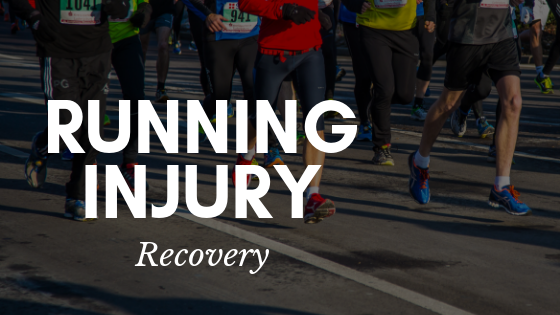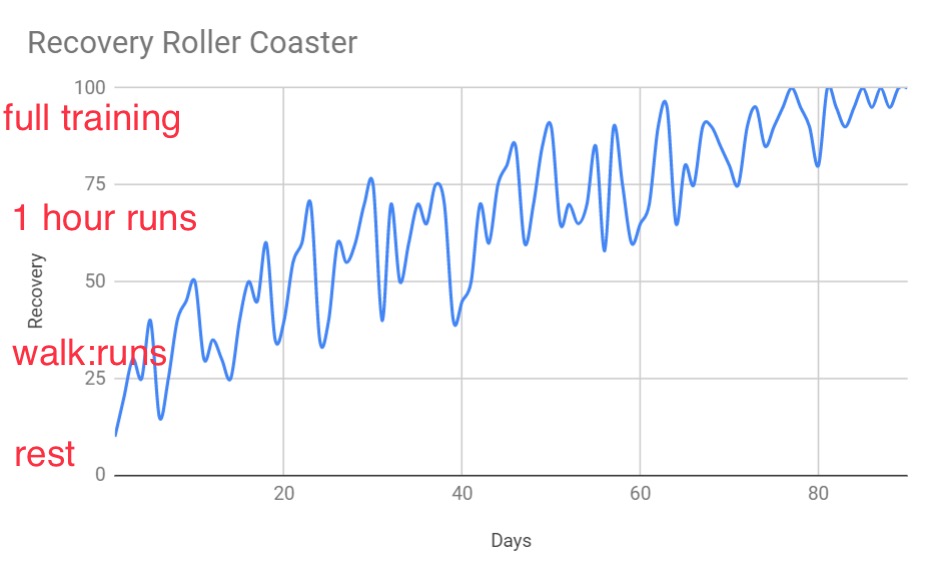
I’ve worked with hundreds of runners and thousands of injured people over the years. Getting a running injury really sucks, I should know, I’ve had dozens. Recovering from a running injury is an art in itself. It never quite goes the way we expect it to and runners often feel like it’s one step forward and two steps back. Today I want to talk about something I’ve come to call the running injury recovery roller coaster.

Running Injury Recovery
The running injury recovery roller coaster applies to any injury of almost any kind. The timeline will vary depending on the nature and the severity of the injury. A simple mild ankle sprain will have a fairly predictable recovery time of 4-12 weeks. A more complicated injury such as an Achilles Tendinopathy may take 3-12 months to fully resolve. Both will require proper rehabilitation in order to ensure that there are no lasting deficits.
Whether the injury is mild or severe, the one thing they will have in common is a fairly up and down path to recovery. There will be good days and bad days, good weeks and bad weeks, good months and bad months. Sometimes you will push too hard and set yourself back. Sometimes you won’t push hard enough and recover slower than you could have. Other times you will do everything right and it will improve quickly. Sometimes you will do everything right and still end up taking a step back! This is just the nature of injury recovery in complicated organisms like humans.
The important thing to notice is the general trend of the Recovery Roller Coaster. Over time, with proper rehabilitation, you should see a gradual improvement in function. Applied specifically to runners, you should see a gradual improvement in your tolerance to running. Initially you may be completely unable to run. After a little while you can do run:walk intervals for a few minutes. Later you can run:walk for an hour. After a little longer you can run continuously for an hour. Then you can start to add some hill training and speed work. Then you can start to gradually increase your mileage. Eventually you will be back to full and unrestricted training.

The key point is that the general trend is towards more and more ability to tolerate running. On the way there, however, there are lots of ups and downs. It’s important not to take the peaks and valleys too seriously. You have to try to look past these daily and weekly fluctuations to see your general trend. I always tell my clients not to get too depressed on the bad days, or too excited on the good days. Take the peaks and valleys with a pinch of salt!
What if the general trend is flat?
Well, then we have a problem! This isn’t actually all that uncommon. Especially for stubborn injuries like tendinitis. The body always wants to heal, it always wants to adapt. If you’re not improving, we need to change something. What we need to change can vary wildly. Sometimes you’re running too much, sometimes not enough. Or you have a specific weakness or stiffness that needs to be addressed. Sometimes you need to change your running technique or your shoes.
Things that make recovery faster
Anything that would generally improve your health will generally increase the speed and capacity of your body to heal the injury or adapt to the demands of running. For example, more sleep, better nutrition, less stress, strength training, general exercise, joyful activities.
Things that make recovery slower
Conversely, anything that would generally reduce your health will reduce the speed of recovery. Less sleep, worse nutrition, more stress, deconditioning muscles, less exercise, miserable activities. I talked about these slightly less obvious but still important concepts in a previous article on preventing running injuries.
Am I actually recovering?
Something that often comes up when working with clients is the fact that the pain is still there. For example, a runner may tell me that their Achilles is still hurting the morning after long runs. Generally speaking, I’m okay with that on two conditions:
- The pain is stable and of a tolerable intensity
- Their overall tolerance to running is improving week on week
Point two just means that their general trend is upwards. Often we will see this type of situation with more chronic or long-term injuries, like tendinitis. The runner still has pain but can do more and more, this is actually a relative improvement and shows an increase in the capacity of the injured tissue to tolerate load (running). We can see this in a really nice illustration from Tom Goom of running-physio.com.
Summary
Recovering from any running injury will have its ups and downs. The overall length of time needed to recover will vary depending on the nature of the injury. Whether you have a minor or major injury you will need to ensure you rehabilitate it properly in order to avoid retaining any strength or flexibility deficits. Regardless of the type of running injury you have you will almost certainly face setbacks along the road to recovery. Thinks of these setbacks as part of the Recovery Roller Coaster and try not to take them too seriously!
